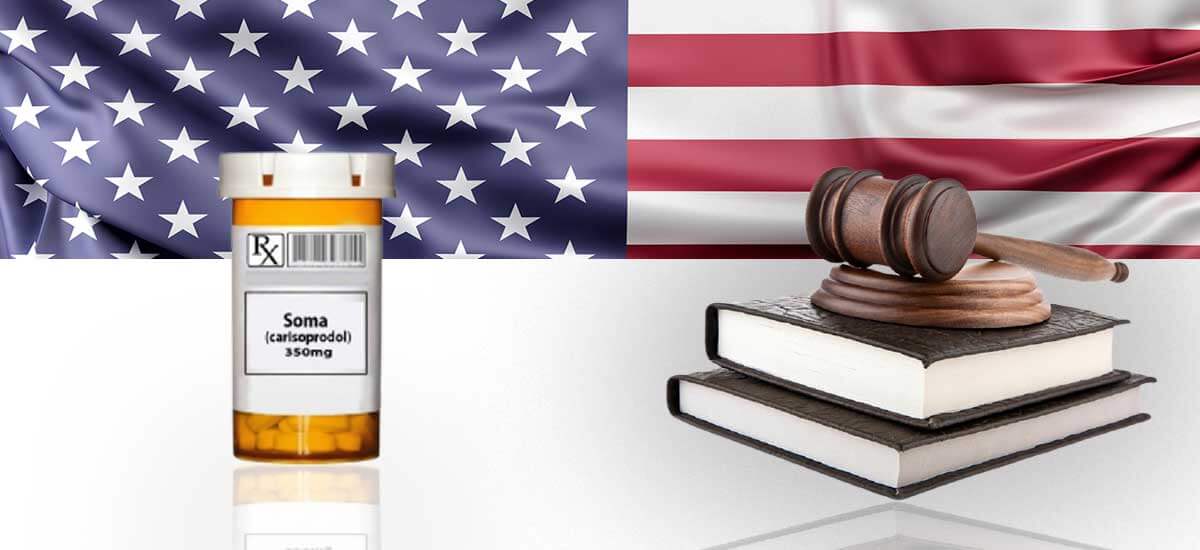Advancements in the medical field have been revolutionary since the dawn of science. Painkillers are some creations that have helped many masses in their distressing moments. However, as helpful drugs, many folks tried and found new ways to abuse them in slang terms for recreation, fueling the consciousness of higher being feeling.
It was one of the prominent reasons for the D.E.A. authorities to control the prescription supply and distribution of substances. Various drugs are declared, held, and scheduled to maintain Public Health and Safety.
As per 2021 D.E.A. records, 571 drugs were identified as controlled substances. Soma Is one of the controlled medicines due to abuse and illicit ways of use in the masses of a broader range of age groups. The above number varies as the authority changes its medicine lists yearly based on research and inspection.
Possession of a controlled substance or illegal distribution can land the person in jail, depending on the person's quantity and another background record.
Let’s have some deeper insights!
A Short Brief Of Soma
Carisoprodol relaxes the muscles. Wallace Laboratories manufactured it in 1959 and sold it under the name Soma in the U.S. One of the most commonly given medications in the United States—a great option for muscle relaxers due to its efficient mode of action and quick relief.
Muscle discomfort has become a frequent complaint among the general public. Muscle soreness can be caused by various factors, including inactivity, sitting employment, and excessive physical exercise. While many muscle relaxers act on muscles, Soma focuses more on pain impulses.
It was believed to have fewer sedative effects than other muscle relaxant medications at first, but it was later discovered to have addictive qualities and the potential for misuse.
How Does Soma Work?
Soma has a fast mechanism to relieve pain. It works on C.N.S. to cut down the pain. Soma has Carisoprodol as an active ingredient that sedates the nervous system to stop the pain signals passing through the brain. Simply, it sedates the signal systems to make you feel less pain.
Consistent use of Carisoprodol can make you dependent and result in addiction. The euphoric effect creates a high and is mainly used for recreation and abuse of drugs. As it is a controlled drug, the sale is highly monitored, and pharmacies having licenses from authorities can bring up Soma for sale.
Medicines are classified in schedules. It depends upon the potential dependence, abuse, or addiction. Soma is a Schedule IV drug.
What Is A Controlled Substance?
A controlled substance is a declaration and classification of a medicine manufacturing, supply, and selling as it can be abused. The government authority controls the company's process to avoid the illegal sale and abuse of drugs or maintain a gap between abuse and actual drug use. These medicines are acquired when you show a prescription from a doctor.
Soma (Carisoprodol) is also a controlled drug; it is a schedule IV drug with low potential but still has many ways to abuse. Soma is a muscle relaxant having a soothing effect that people often use or become dependent on in case of consistent usage. Many times it is also considered a Narcotic, but it is not.
What Does Schedule Drug Means?
Firstly, a schedule drug is a distinguished filtration of medicines depending upon the potential of its abuse, addiction, and dependency. The higher the possibility of abuse, it is considered in most upper-scheduled drug types.
The D.E.A. identifies the drugs into 5 Types of Schedules
Below are the Schedule Types:
Schedule 1:
Drugs classified as Schedule I have no presently recognized medical use and a significant propensity for abuse. Schedule I substances include heroin, lysergic acid diethylamide (L.S.D.), hashish, 3,4-methylenedioxymethamphetamine (ecstasy), methaqualone, and peyote.
Schedule 2:
Schedule II drugs, substances, or chemicals are described as drugs with a high tendency for abuse, with use possibly resulting in profound psychological or bodily reliance. These drugs are also deemed hazardous. Schedule II substances include combo products containing less than 15 mg of hydrocodone per dosage unit (Vicodin), cocaine, methamphetamine, methadone, hydromorphone (Dilaudid), meperidine (Demerol), oxycodone (OxyContin), fentanyl, Dexedrine, Adderall, and Ritalin.
Schedule 3:
Drugs classified as Schedule III have a modest to low inclination for physical and mental dependence. The misuse potential of Schedule III drugs is lower than that of Schedule I and II drugs but higher than that of Schedule IV drugs. Schedule III substances include items with less than 90 mg of codeine per dosage unit (Tylenol with codeine), ketamine, anabolic steroids, and testosterone.
Schedule 4 :
Schedule IV medications, substances, or chemicals have a low tendency for misuse and a common danger of reliance. Schedule IV medications include the following: Valium, Xanax, Soma, Darvon, Darvocet, Ativan, Talwin, Ambien, and Tramadol.
Schedule 5:
Schedule V drugs, substances, or chemicals are described as having a lesser capacity for misuse than Schedule IV drugs and consist of formulations containing small amounts of specific narcotics. Antidiarrheal, antitussive, and analgesic medications are commonly found in Schedule V. Cough preparations containing less than 200 mg of codeine or per 100 milliliters (Robitussin A.C.), Lomotil, Motofen, Lyrica, and Parepectolin are instances of Schedule V medications.
Is Soma A Schedule IV Drug?
In December 2011, the Drug Enforcement Agency decided to control the drug as a Schedule I controlled substance under the Controlled Substances Act (C.S.A.). The D.E.A. (Drug Enforcement Agency) published a final rule (76 FR 77330) in the federal register, making Carisoprodol a Class I controlled substance.
Later on January 11, 2012, the D.E.A. (Drug Enforcement Agency) classified Carisoprodol as a Schedule IV controlled substance at the federal level. The final rule is that as of January 11, 2012, all prescription drugs containing Carisoprodol must comply with 21 C.F.R. SS 130604. The medicines must also have the information required under 21 C.F.R.
Schedule I drugs consist of medications or substances guaranteed to cause extreme addiction and pose a high risk of abuse.
What Kind Of Drug Is Carisoprodol?
Carisoprodol is a muscle relaxant that blocks pain sensations in the brain's nerves. It is often used in resting and physiotherapy to treat skeletal muscles, such as pain and injury. It is also used for recovery, physical therapy, and other measures to relax muscle strains and sprained muscle injuries.
Carisoprodol is the most active and prominent substance present in Soma. Carisoprodol is subject to abuse, dependence, withdrawal, abuse, and criminal diversion. As Soma induces a calming effect, other C.N.S. Depressants like alcohol, benzodiazepines, opioids, and tricyclic antidepressants may be additives.
Is (Soma)Carisoprodol 350 mg A Narcotic?
The typical 350 mg dose is unlikely to cause any prominent side effects except drowsiness, mild to significant euphoria, and dysphoria. Still, these effects are short-lived due to the rapid metabolism of Carisoprodol with meprobamate and other metabolites. They are mainly due to its inherent anxiolytic solid effect, strong enough to produce its primary metabolite, meprobamate, which is falsely blamed for the intense effects of the metabolite.
Although Soma is not a narcotic such as opioids, benzodiazepines, or barbiturates as a controlled substance, it can be combined with these drugs to enhance its effect with significant adverse effects. You can buy somas online or from the nearest pharmacy with a prescription.
The overconsumption of Carisoprodol and other medications will make you tired, decrease your breathing rate, and cause severe side effects, possibly leading to death. Some medicines may affect your blood level or other medications, exacerbating side effects or making the medication less effective.
Suddenly halting the use of Carisoprodol will make you experience severe withdrawal symptoms like insomnia, vomiting, abdominal pain, headaches, tremors, twitching, ataxia, hallucinations, and psychosis.
Does Carisoprodol Make You High?
Yes, Carisoprodol can make you high, but the effects won’t be severe as Soma does not fall in the narcotics category of medications.
When utilized for the treatment of musculoskeletal pain will give a brief euphoric phase while taking effect to relieve muscle tension. The intensity of its speedy action provides users with a high, euphoric feeling known as a high feeling. Due to its toxic effects, doctors usually prescribe Carisoprodol for up to three weeks.
Misuse of the drug carries the risk of overdose, leading to death due to C.N.S. depression (respiratory diseases), hypotension, seizures, and other overdose disorders.
Because of Soma’s potential for abuse, Soma is a controlled substance in 18 U.S. states:
- Alabama
- Arizona
- Arkansas
- Florida
- Georgia
- Hawaii
- Indiana
- Kentucky
- Louisiana
- Nevada
- New Mexico
- Oklahoma
- Oregon
- Texas
- Utah
- Washington
- West Virginia
- Wyoming.
The U.S. drug enforcement agency listed Soma as a drug of concern and is conducting hearings to determine whether it should be classified at the federal level as a controlled substance.
Conclusion
Medicines are controlled to have a healthy impact on the masses, as many painkiller medicines have the potential for addiction and abuse. D.E.A. and governments handle the overall sale to halt the illegal usage and sale of medicine. Soma has a low potential, but still, many folks try new ways to abuse it. Together Soma is a Schedule IV controlled drug.
- “21 USC 812: Schedules of Controlled Substances.” Uscode.house.gov, uscode.house.gov/view.xhtml?req=granuleid:USC-prelim-title21-section812&num=0&edition=prelim. Accessed 22 July 2021.
- Crane, Marisa. “Drug Classifications: Scheduling of Narcotics and Prescription Drugs.” American Addiction Centers, 2018, americanaddictioncenters.org/prescription-drugs/classifications. Accessed 20 July 2021.
- February 3, Editorial StaffLast Updated:, and 2020. “Soma Muscle Relaxers: Addiction to Carisoprodol.” American Addiction Centers, americanaddictioncenters.org/prescription-drugs/soma-addiction. Accessed 24 July 2021.
- “National Cancer Institute.” Www.cancer.gov, 2 Feb. 2011, www.cancer.gov/publications/dictionaries/cancer-terms/def/schedule-i-drug. Accessed 26 July 2021.
- Li, Yan, et al. “Impact of Schedule IV Controlled Substance Classification on Carisoprodol Utilization in the United States: An Interrupted Time Series Analysis.” Drug and Alcohol Dependence, vol. 202, Sept. 2019, pp. 172–77, https://doi.org/10.1016/j.drugalcdep.2019.05.025. Accessed 25 July 2021.



 27 Jul 2021
27 Jul 2021


